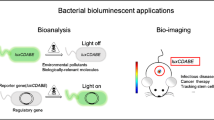Abstract
Conditions that influence the luminescence of natural and recombinant luminescent bacteria in the presence of blood serum were studied. In general, blood serum quenched the luminescence of the marine Photobacterium phosphoreum and the recombinant Escherichia coli strains harboring the luminescent system genes of Photobacterium leiognathi, but enhanced the luminescence of the soil bacterium Photorhabdus luminescens Zm1 and the recombinant E. coli strain harboring the lux operon of P. luminescens Zm1. The quenching effect of blood serum increased with its concentration and the time and temperature of incubation. The components of blood serum that determine the degree and specificity of its action on bacterial luminescence were identified.
Similar content being viewed by others
REFERENCES
Belkin, S., Microbial Whole-Cell Sensing Systems of Environmental Pollutants, Curr. Opin. Microbiol., 2003, vol. 6, no.3, pp. 206–212.
Roda, A., Guardigli, M., Pasini, P., and Mirasoli, M., Bioluminescence and Chemiluminescence in Drug Screening, Anal. Bioanal. Chem., 2003, vol. 377, no.5, pp. 826–859.
Kaiser, K.L. and Esterby, S.R., Regression and Cluster Analysis of the Acute Toxicity of 267 Chemicals to Six Species of Biota and the Octanol/Water Partition Coefficient, Sci. Total Environ., 1991, vol. 109–110, pp. 499–514.
Blaise, C., Forghani, R., Legault, R., and Guzzo, J., Dubow MS. A Bacterial Toxicity Assay Performed with Microplates, Microluminometry and Microtox Reagent, BioTechniques, 1994, vol. 16, no.5, pp. 932–937.
Zieseniss, K. and Grabert, E., A Novel Method for Determining Chronic Toxicity with the LUMIStox Luminescent Bacteria Test, in Bioluminescence and Chemiluminescence: Fundamental and Applied Aspects, 1994, pp. 76–78.
Katalog kul’tur svetyashchikhsya bakterii (Catalog of Fluorescent Bacteria), Rodicheva, E.K., Ed., Novosibirsk: Nauka, SO RAN, 1997.
Illarionov, B.A. and Protopopova, M.V., Cloning and Expression of the Fluorescent System Genes of Photobacterium leiognathi, Mol. Genet. Mikrobiol. Virusol., 1987, no. 8, pp. 41–46.
Manukhov, I.V., Zavil’gel’skii, G.B., and Danilov, V.S., Cloning of the luxAB Genes of the Thermostable Luciferase of Photorhabdus luminescens ZM1 in Escherichia coli K12, Biotekhnologiya, 1999, no. 1, pp. 40–43.
Deryabin, D.G. and Polyakov, E.G., Prospects of Using Luminescent Bacteria for the Evaluation of the Bactericidal Activity of Macroorganism’s Biofluids, in Mater. VIII s”ezda Vseross. obshch. mikrobiol., epidemiol. i parazitol. (Proc. of 8th Congress of the Russian Society for Microbiology, Epidemiology, and Parasitology), Moscow, 2002, vol. 3, p. 253.
Virta, M., Lineri, S., Kankaanpaa, P., Karp, M., Peltonen, K., Nuutila, J., and Lilius, E., Determination of Complement-Mediated Killing of Bacteria by Viability Staining and Bioluminescence, Appl. Environ. Microbiol., 1998, vol. 64, no.2, pp. 515–519.
Immunologicheskie metody (Immunological Methods), Frimelya, G., Ed., Moscow: Meditsina, 1987.
Astaf’ev, D.G. and Mayanskii, A.N., Quantitative Characterization of Human Antibodies against the Peptidoglycans of Various Staphylococci, Zh. Mikrobiol. Epidemiol. Immunobiol., 1987, no. 3, pp. 55–57.
Bukharin, O.V. and Sozykin, V.L., Photonephelometric Method for Determining the Bactericidal Activity of Blood Serum, Faktory Estestvennogo Immuniteta (Natural Immunity Factors), Orenburg, 1979, pp. 43–45.
Ffrench-Constant, R., Waterfield, N., Daborn, P., Joyce, S., Bennett, H., Au, C., Dowling, A., Boundy, S., Reynolds, S., and Clarke, D., Photorhabdus: Towards a Functional Genomic Analysis of a Symbiont and Pathogen, FEMS Microbiol. Rev., 2003, vol. 26, no.5, pp. 433–456.
Kuwae, T., Sasaki, T., and Kurata, M., Chemical and Biological Properties of Lipopolysaccharide from a Marine Bacterium Photobacterium phosphoreum PJ-1, Microbiol. Immunol., 1982, vol. 26, no.6, pp. 455–466.
Virta, M., Karp, M., Ronnemaa, S., and Lilius, E., Kinetic Measurement of the Membranolytic Activity of Serum Complement Using Bioluminescent Bacteria, J. Immunol. Methods, 1997, vol. 201, no.2, pp. 215–221.
Author information
Authors and Affiliations
Additional information
__________
Translated from Mikrobiologiya, Vol. 74, No. 2, 2005, pp. 191–197.
Original Russian Text Copyright © 2005 by Deryabin, Polyakov.
Rights and permissions
About this article
Cite this article
Deryabin, D.G., Polyakov, E.G. Conditions that influence bacterial luminescence in the presence of blood serum. Microbiology 74, 159–163 (2005). https://doi.org/10.1007/s11021-005-0046-3
Received:
Accepted:
Issue Date:
DOI: https://doi.org/10.1007/s11021-005-0046-3




